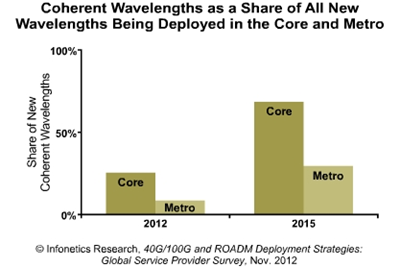マサチューセッツ州ボストン、2012年12月18日-マーケットリサーチ会社のInfonetics Research社は40G/100GおよびROADM設備投資戦略:グローバルサービスプロバイダー調査(40G/100G and ROADM Deployment Strategies: Global Service Provider Survey)からの抜粋を発表した。その中では通信事業者によるオプティカルトランスミッションの移行計画や高速40G/100G伝送への装備の切り替え計画の詳細が明らかにされている。

アナリストノート
「WDMネットワークの40Gと100G間の議論は終わりました。ですから弊社の最新の40G/100GおよびROADM開発戦略:グローバルサービスプロバイダー調査(40G/100G and ROADM deployment strategies survey)では100Gがどのように本格展開していくのか、またどの程度までネットワークがコヒーレント技術とROADMへと移行するのか、について見極めることに焦点を合わせました」とInfonetics Research社のオプティカルの主席アナリストであるAndrew Schmittは説明する。「弊社の調査に参加している通信事業者各社は、2015年までにコヒーレント100Gが殆どのコアネットワークにおいて取って代わると予想しており、一方ROADMは若干メトロへも侵入するのではと予想していることが分かりました。」
40G/100GおよびROADM調査のハイライト
- 調査参加者の間では、2015年までにコヒーレントの配備がコアでは68%、メトロでは29%を占めるだろうと考えられている。
- 100Gは2012年に整備されたネットワークの5%分のみ成長し、2015年には37%となる。
- 通信事業者では、多様なメトロ100Gの取り組みの将来について様々な意見がある。その中には、ダイレクトディテクト100Gやプラガブル・コヒーレント、そして16-QAMのようなアドバンス・モジュレーションなどが含まれている。
- ROADMは、今やオプティカル・ネットワークの大部分を占めており、2つ以上の要因によりROADMノードと等級が大きく勢力を伸ばし始めている。
For its 24-page 40G/100G and ROADM deployment strategies survey, Infonetics interviewed 25 incumbent, competitive, and mobile operators from Europe, North America, Asia, and Latin America about their plans for transitioning to 40G and 100G wavelengths. The study provides insights into reasons for installing 40G and 100G technology, plans for coherent and non coherent detection technology, strategies for deploying 40G and 100G in brownfield and greenfield applications, and ROADM deployment trends.
(原文)
Coherent 100G set to take over core networks, Infonetics optical survey finds
Boston, MASSACHUSETTS, December 18, 2012-Market research firm Infonetics Research released excerpts from its 40G/100G and ROADM Deployment Strategies: Global Service Provider Survey, which details the plans of operators transitioning optical transmission and switching equipment to higher-speed 40G and 100G wavelengths.
ANALYST NOTE
"The debate between 40G and 100G in WDM networks is over, so for our latest 40G/100G and ROADM deployment strategies survey we focused on identifying how the rollout of 100G will take place and to what degree networks will migrate to coherent technology and ROADMs," explains Andrew Schmitt, principal analyst for optical at Infonetics Research. "What we found is that operators participating in our study expect coherent 100G to take over most core networks by 2015 and even make some minor inroads into the metro, while ROADM."
40G/100G AND ROADM SURVEY HIGHLIGHTS
- Among survey respondents, by 2015 coherent wavelengths will account for 68% of deployments in the core and 29% in the metro
- 100G will rise from just 5% of deployed wavelengths in 2012 to 37% in 2015
- Carriers have mixed opinions on the future of various metro 100G approaches, including direct detect 100G, pluggable coherent, and advanced modulations such as 16-QAM
- ROADMs are now a major part of optical networks, with ROADM nodes and degree counts set to surge by a factor of more than 2

